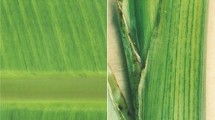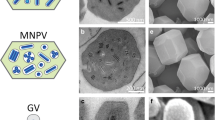Abstract
Mycovirus infection is a universal phenomenon in the major fungus groups. So far, however, mycoviruses have not been described in the phytopathogenic fungus Leptosphaeria biglobosa, the causal agent of phoma stem canker (blackleg). Here, we report the complete genome sequence of a novel mitovirus, Leptosphaeria biglobosa mitovirus 1 (LbMV1), isolated from the strain H3-38 of L. biglobosa. The LbMV1 genome comprises 2568 nucleotides with a low G+C content of 30%. Using the mitochondrial genetic code, the genome of LbMV1 was found to contain a single large open reading frame that encodes a predicted protein of 756 amino acids. Multiple alignment of the predicted protein sequence showed the highest similarity (51% identity) to the putative RNA-dependent RNA polymerase of Ophiostoma mitovirus 4. In addition, phylogenetic analysis grouped LbMV1 within the genus Mitovirus of the family Narnaviridae. Our results suggest that the double-stranded RNA found in strain H3-38 is the replicating genome of the mitovirus LbMV1, its deletion represents the first evidence of a mycovirus infecting L. biglobosa.


Similar content being viewed by others
References
Ghabrial SA, Caston JR, Jiang D, Nibert ML, Suzuki N (2015) 50 plus years of fungal viruses. Virology 479:356–368
Pearson MN, Beever RE, Boine B, Arthur K (2009) Mycoviruses of filamentous fungi and their relevance to plant pathology. Mol Plant Pathol 10(1):115–128
Yu X, Li B, Fu Y, Jiang D, Ghabrial SA, Li G, Peng Y, Xie J, Cheng J, Huang J, Yi X (2010) A geminivirus-related DNA mycovirus that confers hypovirulence to a plant pathogenic fungus. Proc Natl Acad Sci USA 107(18):8387–8392
Hillman BI, Cai G (2013) The family Narnaviridae: simplest of RNA viruses. Adv Virus Res 86:149–176
Fitt BD, Brun H, Barbetti MJ, Rimmer SR (2006) World-wide importance of phoma stem canker (Leptosphaeria maculans and L. biglobosa) on oilseed rape (Brassica napus). Eur J Plant Pathol 114(1):3–15
Huang YJ, Fitt BD, Jedryczka M, Dakowska S, West JS, Gladders P, Li ZQ (2005) Patterns of ascospore release in relation to phoma stem canker epidemiology in England (Leptosphaeria maculans) and Poland (Leptosphaeria biglobosa). Eur J Plant Pathol 111(3):263–277
Mendes-Pereira E, Balesdent MH, Brun H, Rouxel T (2003) Molecular phylogeny of the Leptosphaeria maculans-L. biglobosa species complex. Mycol Res 107(11):1287–1304
Shoemaker RA, Brun H (2001) The teleomorph of the weakly aggressive segregate of Leptosphaeria maculans. Can J Bot 79(4):412–419
West JS, Balesdent MH, Rouxel T, Narcy JP, Huang YJ, Roux J, Schmit J (2002) Colonization of winter oilseed rape tissues by A/Tox+ and B/Tox Leptosphaeria maculans (phoma stem canker) in France and England. Plant Pathol 51(3):311–321
Liu SY, Liu Z, Fitt BD, Evans N, Foster SJ, Huang YJ, Latunde-Dada AO, Lucas JA (2006) Resistance to Leptosphaeria maculans (phoma stem canker) in Brassica napus (oilseed rape) induced by L. biglobosa and chemical defence activators in field and controlled environments. Plant Pathol 55(3):401–412
Liu Z, Latunde-Dada AO, Hall AM, Fitt BD (2014) Phoma stem canker disease on oilseed rape (Brassica napus) in China is caused by Leptosphaeria biglobosa ‘brassicae’. Eur J Plant Pathol 140(4):841–857
Luo T, Cai X, Li G, Yang L (2018) First report of Leptosphaeria biglobosa causing blackleg on broccoli (Brassica oleracea var. italica) in central China. Plant Dis 102(6):1178
Darissa O, Willingmann P, Adam G (2010) Optimized approaches for the sequence determination of double-stranded RNA templates. J Virol Methods 169(2):397–403
Xiao X, Cheng J, Tang J, Fu Y, Jiang D, Baker TS, Xie J (2014) A novel partitivirus that confers hypovirulence on plant pathogenic fungi. J Virol 88(17):10120–10133
Xie J, Wei D, Jiang D, Fu Y, Li G, Ghabrial S, Peng Y (2006) Characterization of debilitation-associated mycovirus infecting the plant-pathogenic fungus Sclerotinia sclerotiorum. J Gen Virol 87(1):241–249
Kumar S, Stecher G, Tamura K (2016) MEGA7: molecular evolutionary genetics analysis version 7.0 for bigger datasets. Mol Biol Evol 33(7):1870–1874
Author information
Authors and Affiliations
Corresponding author
Ethics declarations
Funding
This work was supported by the National Nature Science Foundation of China (31601588), National Key Research and Development Program of China (2017YFD0201100), and the China Agriculture Research System (CARS-13).
Conflict of interest
All authors declare that they have no conflicts of interest.
Ethical approval
This article does not contain any studies with human participants or animals performed by any of the authors.
Additional information
Handling Editor: Massimo Turina.
Publisher's Note
Springer Nature remains neutral with regard to jurisdictional claims in published maps and institutional affiliations.
Electronic supplementary material
Below is the link to the electronic supplementary material.
705_2018_4143_MOESM1_ESM.tif
Supplementary material 1 (TIFF 6253 kb) Fig. S1 Predicted secondary structures of the 5’ and 3’ termini of the LbMV1/H3-38 genome. (A) The predicted 5’ stem-loop structure (B) The predicted 3’ stem-loop structure
705_2018_4143_MOESM2_ESM.tif
Supplementary material 2 (TIFF 10193 kb) Fig. S2 Alignment of the amino acid sequences of the putative RNA-dependent RNA polymerases of Leptosphaeria biglobosa mitovirus 1 and five other mitoviruses. Six conserved motifs are numbered I to VI
705_2018_4143_MOESM3_ESM.tif
Supplementary material 3 (TIFF 709 kb) Fig. S3 Strain H3-38 was molecularly identified with primers ITS1/ITS4, LmacF/LmacR and LbigF/LmacR. The lanes 1 and 2 represent the DNA amplicons of H3-38 and the negative control (sterile water), respectively. M represents the DNA molecular marker
Rights and permissions
About this article
Cite this article
Wang, Y., Xu, Z., Cheng, J. et al. Characterization of a novel RNA virus from the phytopathogenic fungus Leptosphaeria biglobosa related to members of the genus Mitovirus. Arch Virol 164, 913–916 (2019). https://doi.org/10.1007/s00705-018-04143-3
Received:
Accepted:
Published:
Issue Date:
DOI: https://doi.org/10.1007/s00705-018-04143-3




